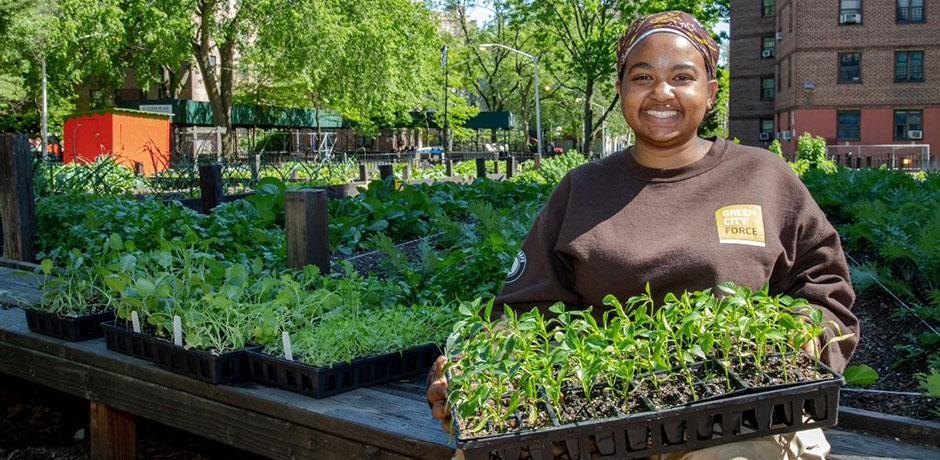Little Known Facts About City Blooming.
Little Known Facts About City Blooming.
Blog Article
Excitement About City Blooming
Table of ContentsCity Blooming for DummiesThe 15-Second Trick For City BloomingAll about City BloomingThe 9-Minute Rule for City BloomingCity Blooming for Dummies
Intrigued in growing food offer for sale in the City of Chicago? Considering starting a community garden? Modifications to the Chicago Zoning Ordinance enable farming uses like community yards and urban ranches in several components of the city. Below is a listing of often asked questions regarding the policies and laws that growers should take into consideration when planning a metropolitan agriculture job.
The zoning amendment does not modify any kind of various other codes managing composting, building authorizations, buying or leasing City had residential property, company licenses or ecological contamination. There are existing codes that regulate these problems and they remain in complete effect and may be relevant to your job. Neighborhood gardens are normally owned or managed by public entities, public companies or community-based companies and kept by volunteers.
Urban ranches grow food that is meant to be offered, either on a not-for-profit or for-profit basis. Because of their business purpose, metropolitan ranches call for a business permit. Yes. An area garden is enabled to sell surplus produce that was grown on website if the sales are accessory or subservient to the yard's main objective described above.
Not known Details About City Blooming
Composting is enabled yet only for plant material that is created and made use of on website. The amount of garden compost product can not go beyond 25 cubic backyards at any type of offered time according to the requirements in 7-28-715 of the City's Municipal Code. Yes. Due to the fact that the dirt at the majority of brand-new yard websites needs changing, compost, dirt, wood chips, or other materials can be gotten to create or boost the expanding room - balcony and patio garden design.

If a structure authorization is required then the hoophouse will certainly be thought about an accessory structure. You can locate out more concerning the building authorization requirements by contacting the Department of Structures. The 25,000-square-foot size restriction is intended to protect against a single community yard from controling a provided block or interfering with the block's existing household or commercial personality.
The limit does not relate to gardens situated in Public Open Area (POS) districts. Can there be even more than one area garden that is 25,000 square feet on a solitary block? Yes. The size limitation applies to specific gardens, not to individual blocks. No. Fence is not called for, nevertheless, yards that have huge auto parking areas may be needed to install fence or other landscape design features.
A Biased View of City Blooming
B1 & B2 areas need that all business usage tasks be conducted inside your home. Is secure fencing needed for urban ranches? Fences may be required, along with landscaping and screening, for specific car park areas and outdoor job or storage locations depending on area and the certain activity taking place.
Yes. Urban ranches require building permits and zoning authorizations prior to construction. Various other kinds of city review might be called for depending on certain structures, tasks, dimension, landscape design, licensing, public heath and stormwater administration problems. Most of these requirements are determined in the project design or allowing procedure, nonetheless, the applicant may be responsible to independently identify specific licenses or allows that may be called for.
Yes. The sort of permit is identified by what is happening at the site. The Division of Service Matters and Customer Defense can assist identify the certain sort of company permit that's needed. Yes. Off street vehicle parking is required for most commercial tasks in Chicago. The needed number of auto parking areas is based upon the variety of workers servicing website and not the square video of the growing their website space.
All about City Blooming

Yes. An urban farm can offer garden compost material created on website, nonetheless, the operation has to follow the guidelines in 7-28-715 of the Chicago Municipal Code. Yes. Aquaponic systems are permitted inside on urban ranches in numerous zoning areas. A zoning evaluation and building license is needed in order to install structures or systems and a business certificate is required as described over.
Up to five hives or colonies of honey bees may be maintained as an accessory usage. Beekeepers should register with the Illinois Department of Agriculture. To find out more regarding the suggested zoning change you may call the Division of Real Estate and Economic Growth, Bureau of Planning and Zoning at 312.744.8563.
, which takes place in country locations at the side of suburbs.
The Ultimate Guide To City Blooming
, that look for to create social networks established on a shared values of nature and neighborhood holism. These networks can develop by means of formal institutional assistance, ending up being integrated into neighborhood community preparation as a "shift town" movement for lasting metropolitan development.
Some of the first evidence of urban agriculture comes from Mesopotamia.
Report this page